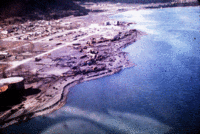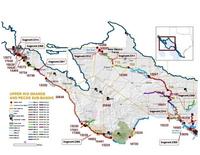-
Barrier systems, robots reduce security costs
High-security compounds have traditionally employed security guards to protect buildings and facilities, deter intrusion, and prevent theft, but as budget cuts continue to force both private and government organizations to cut staff, some agencies are deploying portable barrier systems and robots tasked with securing organizations and their assets.
-
-
Sea level rise, shoreline changes leading influences on flooding from hurricanes
Recent studies into coastal flooding have focused on climate change impacts on the intensity and frequency of tropical cyclones themselves, but researchers say that two other factors contribute even more to the growing threats to coastal communities: sea level rise and shoreline retreat. Researchers highlight sea level rise and its potential dramatically to change the coastal landscape through shoreline erosion and barrier island degradation, and say that it is an under-appreciated and understudied factor that could lead to catastrophic changes in flood risk associated with tropical cyclones, known as hurricanes in the North Atlantic.
-
-
Asteroid hunter spacecraft returns first images after reactivation
In 2010 and early 2011, NASA’s Near-Earth Object Wide-field Infrared Survey Explorer (NEOWISE), a spacecraft that made the most comprehensive survey to date of asteroids and comets, discovered more than 34,000 asteroids and characterized 158,000 throughout the solar system. It was reactivated in September following thirty-one months in hibernation, to assist NASA’s efforts to identify the population of potentially hazardous near-Earth objects (NEOs).
-
-
NERC’s critical infrastructure protection standards ambiguous, unclear: analysts
In January 2008, to counter cybersecurity threats to critical infrastructure assets such as bulk electricity supply (BES), North American Electric Reliability Corp.’s (NERC) launched its Critical Infrastructure Protection (CIP) standards for BES cybersecurity. The NERC-CIP is marked by uncertainties and ambiguous language, raising concerns in the industry and among industry observers as companies try to enforce the standards. “Industry now screams for a defined control set with very specific requirements that don’t permit subjective and ambiguous interpretations,” comments one analyst.
-
-
2014 Cybersecurity Forum to focus on Trusted Computing
The 2014 Cybersecurity Innovation Forum, to be held 28-30 January 2014, at the Baltimore Convention Center in Baltimore, Maryland, will focus on the existing threat landscape and provide presentations and keynotes on current and emerging practices, technologies and standards to protect the nation’s infrastructure, citizens and economic interests from cyberattack.
-
-
Exploring geoengineering research, ethics, governance
Hacking the Earth’s climate to counteract global warming — a subject that elicits strong reactions from both sides — is the topic of a December special issue of the journal Climatic Change. A dozen research papers include the most detailed description yet of the proposed Oxford Principles to govern geoengineering research, as well as surveys on the technical hurdles, ethics, and regulatory issues related to deliberately manipulating the planet’s climate.
-
-
Japan tsunami exacerbated by landslide

The 2011 Japan tsunami, which killed up to 20,000 people and caused the partial meltdown of the Fukushima nuclear plant, was made worse by an underwater landslide, according to scientists. “The earthquake alone cannot explain the height of the waves along the Sanriku coast of northern Honshu Island,” says one scientist. “They were generated by a submarine landslide.” The research poses a big problem for early-warning systems, because where the risk of landslides goes unrecognized, tsunamis generated by similar earthquakes could be seriously underestimated.
-
-
Enjoy it while you can: 850 million more years before oceans boil away

Scientists had estimated that the Earth’s oceans would boil away in about 150 million years. The reason: the sun expands as it runs out of hydrogen fuel, and that expansion, 150 million years from now,would cause “runaway” global warming leading to the boiling of the oceans. Scientists have now found that the Earth’s “Goldilocks Zone” — where it is neither too hot nor too cold for liquid to exist on a planet orbiting a star— is slightly larger than previously thought, meaning Earth has bought itself some additional time — about 700 million years – before the oceans evaporate.
-
-
Cybersecurity giants adapt to changing cyberthreat landscape
McAfee and Symantec, the two technology giants of traditional firewall and antivirus protection software, are shifting their attention to focus more on cybersecurity challenges. A rapidly changing landscape for computer networks, in which data is transmitted and stored via mobile devices and cloud computing, has created demand for products and services that can secure information against state-sponsored or organized cyber terrorism.
-
-
DHS announces expansion of cyber student volunteer initiative
DHS the other day announced the launch of the 2014 Secretary’s Honors Program (SHP) Cyber Student Volunteer Initiative for college students. Through the program, more than 100 unpaid student volunteer assignments will be available to support DHS’ cyber mission at local DHS field offices in over sixty locations across the country.
-
-
Upper Rio Grande to experience growing gap between water supply and demand

Increasing temperatures and changes in the timing of snowmelt runoff could impact the amount of water available on the upper Rio Grande in the future, says a news study. Temperatures will increase four to six degrees Fahrenheit by the end of the twenty-first century, according to the climate modeling used in the study. Although the modeling projects that total annual average precipitation in the basin will not change considerably, we are likely to see a decreasing snowpack, an earlier and smaller spring snowmelt runoff and an increase in the frequency, intensity and duration of both droughts and floods.
-
-
Post-Sandy study shows a polluted but largely intact barrier system off Long Island
As coastal communities continue to rebuild in the wake of Hurricane Sandy, scientists last week reported some encouraging news: The storm did not seriously damage the offshore barrier system that controls erosion on Long Island. Long-term concerns remain about the effects on the region of sea-level rise, pollutants churned up by the storm within back-barrier estuaries, and the damage closer to shore, but in the near-term, Long Island residents can rebuild knowing that Hurricane Sandy did not significantly alter the offshore barrier systems that control coastal erosion on the island.
-
-
Scrapping sea level protection puts Australian homes at risk
As the science on the coastal impacts of climate change gets stronger, the protections for Australia’s coastal communities are getting weaker. Along the eastern seaboard of Australia, where most Australians live, state governments are relaxing their policies and largely leaving it to local councils to decide if homes can be built in low-lying areas.Over the past fifty years, there have been twenty-five national inquiries and reports into coastal management. Those inquiries have overwhelmingly come to the conclusion that rather than leaving it to local councils, Australia needs one set of clear, national guidelines on coastal development and infrastructure. That is the opposite of what we are now seeing around Australia, with a mish-mash of different rules in different states. If that continues, everyone will pay.
-
-
Global map predicts giant earthquakes
Researchers have developed a new global map of subduction zones, illustrating which ones are predicted to be capable of generating giant earthquakes and which ones are not. The research comes nine years after the giant earthquake and tsunami in Sumatra in December 2004, which devastated the region and many other areas surrounding the Indian Ocean, and killed more than 200,000 people.
-
-
Cybersecurity isn’t all about doom and gloom
Much is made in the press of the devastating effects that weak cybersecurity is having on the economy in the United Kingdom and globally. The threat is compounded by a significant skills shortage. The U.K. government thinks the problem is so severe that it has identified cybersecurity as a Tier 1 national security threat and invested 860 million pounds to defend the country’s digital shores. What all this means is that there is money to be made from cybersecurity and small businesses should not fear it but embrace it. The business opportunities are boundless in cybersecurity. One area that is promising in this sense is the move towards smart cities. As the infrastructure around us, such as traffic lights and utilities becomes more regularly controlled via computers, market opportunities emerge
-
- All
- Regional
- Water
- Biometrics
- Borders/Immig
- Business
- Cybersecurity
- Detection
- Disasters
- Government
- Infrastructure
- International
- Public health
- Public Safety
- Communication interoperabillity
- Emergency services
- Emergency medical services
- Fire
- First response
- IEDs
- Law Enforcement
- Law Enforcement Technology
- Military technology
- Nonlethal weapons
- Nuclear weapons
- Personal protection equipment
- Police
- Notification /alert systems
- Situational awareness
- Weapons systems
- Sci-Tech
- Sector Reports
- Surveillance
- Transportation
Advertising & Marketing: advertise@newswirepubs.com
Editorial: editor@newswirepubs.com
General: info@newswirepubs.com
2010-2011 © News Wire Publications, LLC News Wire Publications, LLC
220 Old Country Road | Suite 200 | Mineola | New York | 11501
Permissions and Policies
Editorial: editor@newswirepubs.com
General: info@newswirepubs.com
2010-2011 © News Wire Publications, LLC News Wire Publications, LLC
220 Old Country Road | Suite 200 | Mineola | New York | 11501
Permissions and Policies
